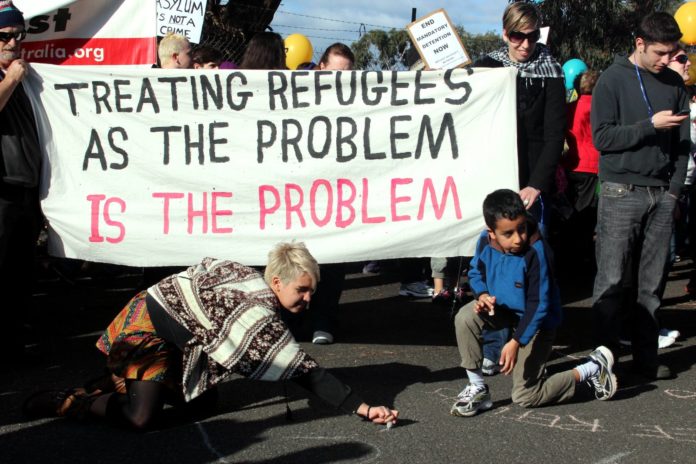
A video of a child being torn away from the arms of a woman did its rounds on social media on Wednesday. The disturbing incident happened as police forcibly removed hundreds of refugees from outside the offices of the UN High Commission for Refugees in the Cape Town CBD. For the past few weeks, foreign nationals and refugees have staged a peaceful sit-in protest there over safety concerns in South Africa.
South Africa is not the only country facing a refugee crisis, the crisis is global (hello Brexit). But South Africa has experienced three major spates of xenophobic violence over the past decade and it isn’t getting any better. The country’s asylum management process system is also failing which only exacerbates xenophobia, according to a new Amnesty report. The Daily Vox explains.
Know the different terminology: refugees, asylum seekers, migrants
There is a difference between refugees, asylum seekers, and migrants and the distinction is important because each has a different implication within the law. Refugees are people who are forced to flee their home countries because to escape armed conflicts, persecution or natural disasters. Their dire situations mean they seek safety in other countries, becoming recognised as refugees with access to assistance from states and aid organisations.
An asylum seeker is a person who leaves their home country to seek asylum in another. An asylum seeker claims to be a refugee, but their claim hasn’t yet been evaluated. This person applies for asylum on the basis that returning to his or her country would lead to persecution because of their race, religion, nationality or political beliefs. A person will remain an asylum seeker as long as their application is pending. But while not every asylum seeker will be recognised as a refugee, every refugee is initially an asylum seeker.
Migrants do not necessarily move because of threat or persecution but because to improve their lives for work, better education, to be with family. Migrant, unlike refugees, can return home if they want.
How many refugees are there in the world?
There were 70.8 million forcibly displaced people worldwide by the end of 2018, according to the June 2019 United Nations Refugee Agency (UNHCR) Global Trends Report. Of that 70.8 million people, 41.3 million people were internally displaced, 25.9 million people were refugees, and a further 3.5 million people were asylum seekers.
And how many refugees are there in South Africa?
Sadly, there’s limited data available in South Africa from both the UNHCR and the department of home affairs so it’s difficult to say.
What does South African law say about refugees?
Refugees in South Africa are protected under the Refugees Act No. 130 of 1998 and the Immigration Act.
Internationally, refugees are also protected under the 1951 UN Refugees Convention, the 1967 Protocol Relating to the Status of Refugees and the 1969 Organisation of African Unity (OAU) Convention regarding Specific Aspects of Refugees in Africa.
In 1993, under the Basic Agreement reached between the South African government and UNHCR, South Africa agreed to abide by the definitions contained in the U.N. 1951 Convention and the 1969 OAU Convention in determining refugee status.
The South African Constitution also gives certain rights to all who live in it, and not just South African citizens. These include the rights to life, equality, dignity, housing, health, education, and so forth.
So basically, according to the law and international obligations, the South African government has an obligation to grant protection to refugees and other persons in need of protection.
How does an asylum seeker get refugee status in South Africa?
- Getting a Section 22 permit
Once a person enters South Africa claiming to be an asylum seeker, the person gets a section 23 permit. This is a non-renewable “asylum transit permit” of the Immigration Act valid for 14 days. It authorises the person to report to the nearest Refugee Reception Office (RRO) to apply for asylum. The asylum seeker is expected to put in their application in person at an RRO, where an admissibility hearing takes place.
If successful, the person is issued with a section 22 permit valid for six months, which legalises the asylum seeker’s stay in South Africa temporarily pending a final decision. The RRO can extend the permit for a further six months during the process of status determination. The holder of section 22 permit has the right to work and study in South Africa, protected against deportation. But the process is not over.
- From Section 22 Permit to refugee
Section 22 permit holders have to regularly renew their permit until they are asked to return for the second interview. This could take up to 20 years, but more on that later. The second interview or the Status Determination hearing is conducted by a Refugee Status Determination Officer (RSDO). The RSDO determines whether the person qualify for refugee status based on their application and interview. After this interview, the RSDO will give permit holders a date to go back to the refugee office for a decision on the application. This could take 60 days or more.
But there’s a backlog of appeals and reviews…
There is a 96% rejection rate of asylum applications and an estimated 190 000 applications sitting in the backlog of appeals and reviews. This is according to a new Amnesty International report titled Living In Limbo: Rights Of Asylum Seekers Denied. Without proper documentation, hundreds of thousands of applicants live in South Africa, exacerbating xenophobia in the country. An Africa Check report indicates that South Africa had the second-largest multi-year backlog of unsettled asylum cases in the world in 2015.
The Amnesty report also records poor treatment of asylum seekers and the xenophobia they experience while living undocumented in South Africa. It’s a tough situation because as much as the law is progressive, South Africa is failing at implementation.








